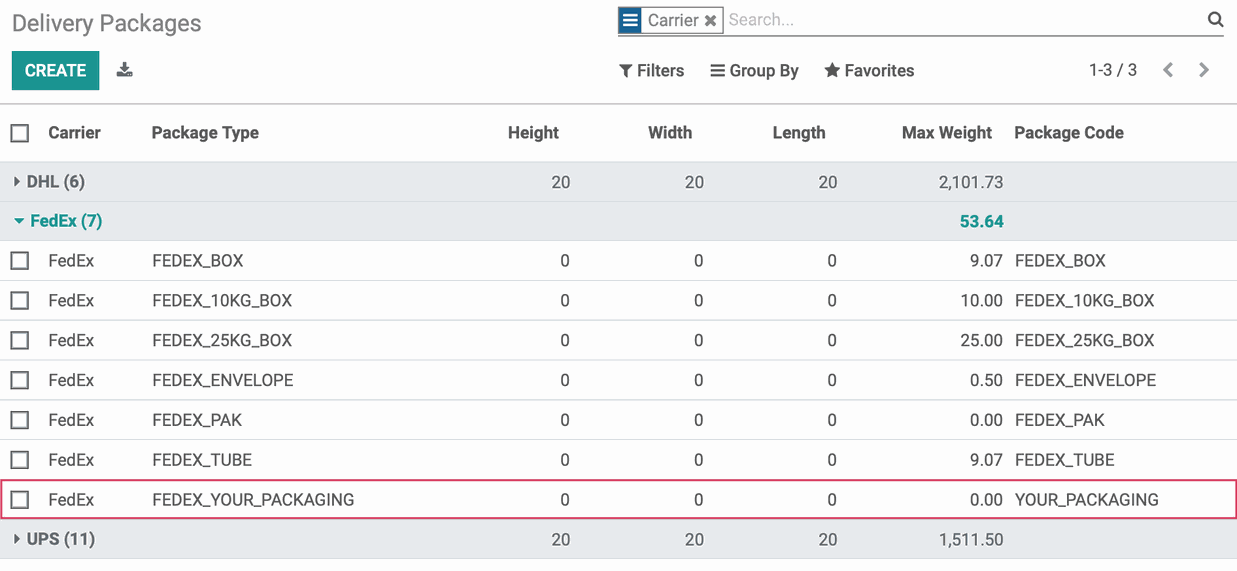Inventory : Configuration: Delivery
Purpose
The purpose of this document is to show you how to create different shipping methods in the Odoo 14 Inventory application.
Process
To get started, navigate to the Inventory app.
![]()
Once there, go to Configuration > Delivery > shipping methods.
Creating a Shipping Method
Your initial view will be a listing of all current shipping methods. Click Create to add a new Shipping Method. A form will appear with the following options:
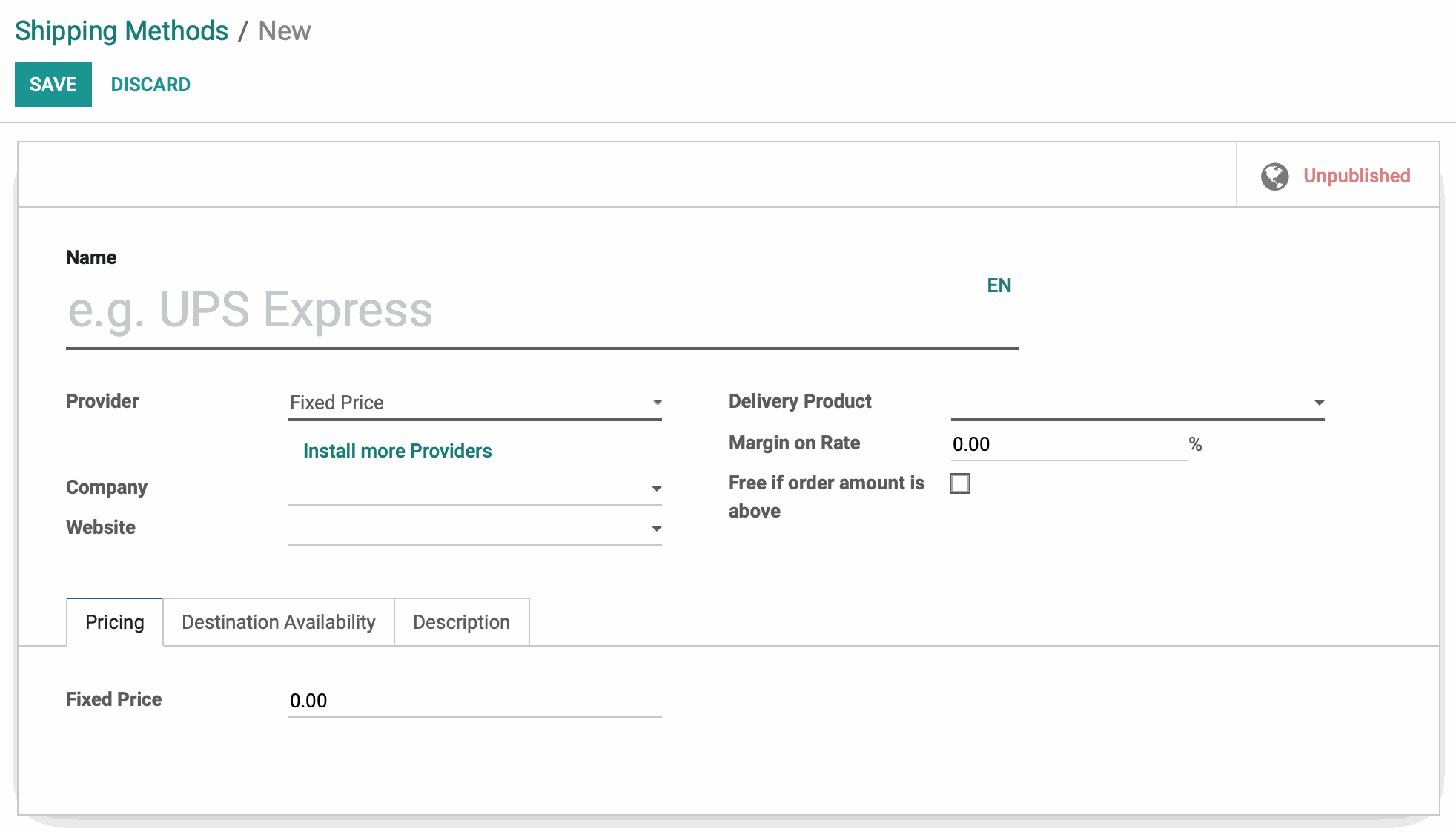
Name: Give your Delivery Method a specific name for reference.
Provider: Set the pricing that will be used for this shipping method from various sources. We will only cover "Fixed Price" and "Based on Rules" right now as 3rd party carrier set up is covered in the next section.
Fixed Price: This gives you the option to set a fixed shipping cost for all orders that this Delivery Method is applied to.
Based on Rules: This will allow you to set specific rules for your shipping costs based on weight, price, quantity ordered, volume, and weight * volume. For example, you could set your rules so that, if an order contains more than five units and the price is over $200, then that customer gets free shipping.
Install more providers: Takes you to a page where you can install additional logistics provider modules and Shipping Connectors.
Company: Leave this field empty to allow this shipping method to be used by all companies. To restrict this method to only one company, select it company here.
Website: Leave this field empty to display this shipping method to be used by all websites. To display this method on only one website select that company here.
Delivery Product: Delivery Products are used for internal accounting purposes. By having an associated Delivery Product with your Delivery Method, you can track how many times a Delivery Method is used. Delivery Products also add a line item to all orders that use the associated Delivery Method for accurate billing of the shipping costs. We will go over how to create Delivery Products below.
Margin on Rate: Set a percentage of increase over the calculated shipping rate.
Free if order amount is above: If enabled, you can set an order price that, if reached, will give your customers free shipping.
Under the Pricing tab, set the price, and pricing rules, for the Fixed Price and Based on the Rules options above. To see how to add a new pricing rule when the Provider is set to "Based on Rules", please review this Shipping Methods document.
Under the destination availability tab, you can restrict your shipments to certain regions by country and state, if desired.

Countries: Select all countries this shipping method is valid for.
States: Select all states within your selected countries this shipping method is valid for. If your Country field is blank, selecting a state will populate the Country field but you'll need to re-select the states you already entered.
Zip From: If applicable, enter a zip code for where your shipment is originating.
Zip To: If applicable, enter a zip code for your shipment's destination.
Under the Description tab, enter a description for this Shipping Method that will display on the eCommerce application and in online quotations.
Once you've configured your new Shipping Method, click Save.
Delivery Products
Delivery Products are accessed by the associated dropdown menu within any Shipping Method.
On any selected Shipping Method, when selecting a Delivery Product from the dropdown menu, you will see all of the Delivery Products that have already been made, as well as the preconfigured Delivery Products that are associated with the selected Shipping Connector(s).
To create a new Delivery product for your selected Shipping method, start typing in this field then, from the dropdown menu, select CREATE AND EDIT....
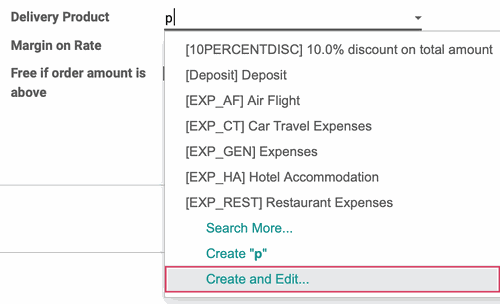
A form titled Create: Delivery Product will appear for configuration of the new Delivery Product:
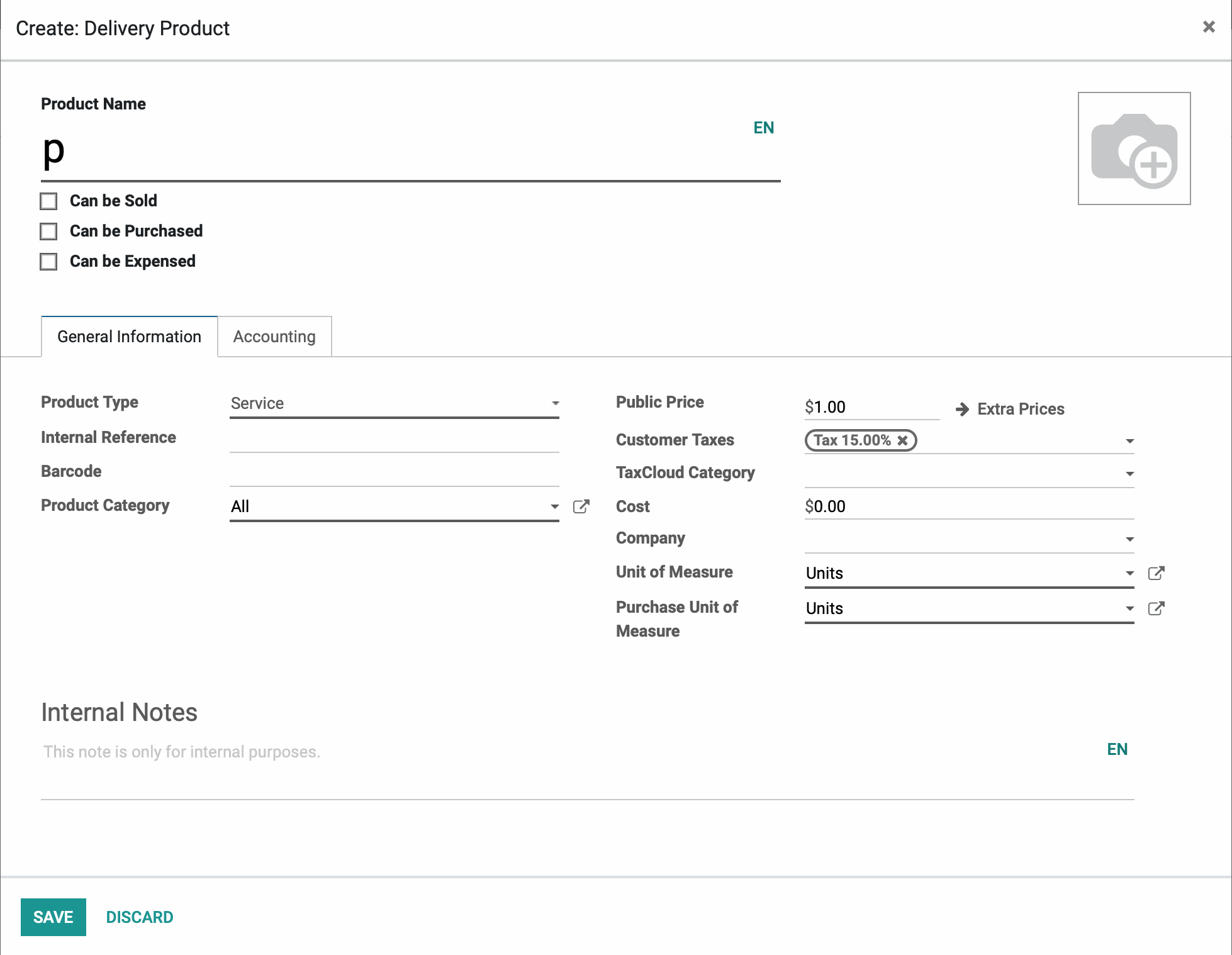
A Delivery Product is managed like a regular Service product. Enter all information according to the Master Data: Products documentation. When finished, click Save.
Shipping Connectors
Return to the list of your Shipping Methods by going to configuration > shipping methods. Within this list, you will see all of the Shipping Methods in the system for the Shipping Connectors that have been installed.
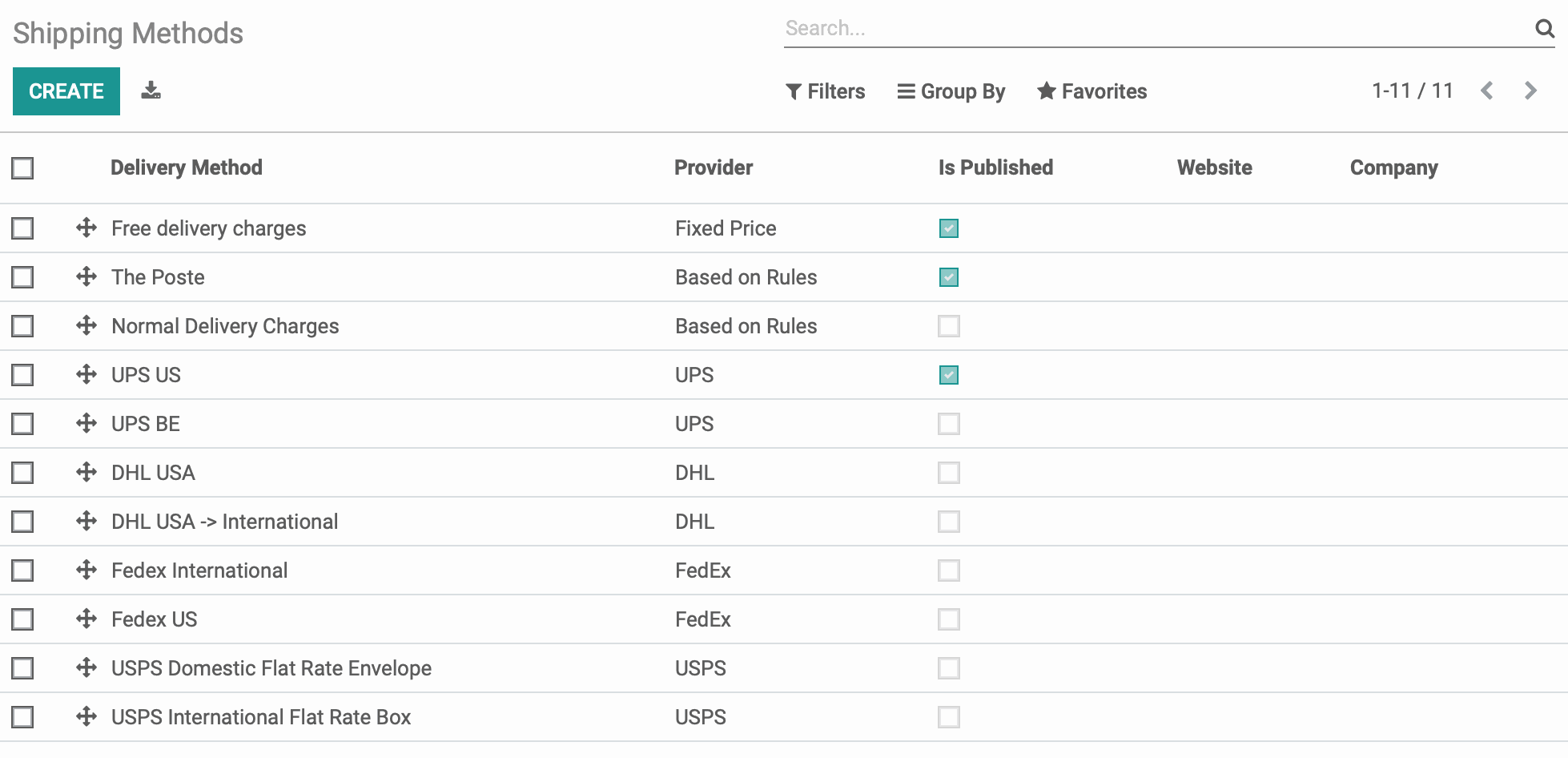
Select a Shipping Method from the list, then click edit.
To get started with connecting your selected carrier's account with Odoo, navigate to the configuration tab. The fields on this tab will vary based on the carrier you've selected. Refer to the configuration instructions for the specific carrier module for further instruction.
Good to Know!
Integration Level
Some shipping carriers' configurations will have an Integration Level option. This section allows you to choose how much of the shipping process will be handled within Odoo. You can opt to just get shipping rates, or you can opt to get rates and create a shipment.

When you're done, click Save.
Smart Buttons
You may notice up to three Smart Buttons at the top of your Shipping Methods screen:

Unpublished / Published: When toggled to Published, this Shipping Method becomes available on the configured Company(ies) and Website(s).
Test Environment / Production Environment: When toggled to Production Environment, the connector will connect with your carrier and be ready to use for live orders.
No debug / Debug requests: When toggled to Debug requests, processes and errors will be logged for your review.
Important!
Test vs. Production
Once you have your Shipping Connector activated for a carrier and you create a Delivery Method, you will have the option of switching between a Test Environment and a Production Environment for that carrier.
While testing your connection and making sure that your preferences are correct, you should be in the Test Environment. Once you are ready to start processing live orders or doing testing in a live environment, you can switch to Production Environment.
To toggle between the two environments, just click Test Environment / Production Environment on any Shipping Method that you are editing. If you are on Test Environment, a single click will put you on Production, and vice versa.

Generally, your test credentials and your production credentials from the shipping provider will be different. Please contact your shipping provider to receive both sets of credentials.
Delivery Packages
Knowing the type of packaging you're using is helpful to determine accurate shipping rates.
To enable Delivery Packages, go to Configuration > settings. Under the Operations section, enable Packages.
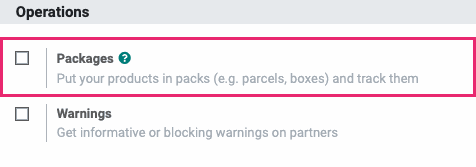
When ready, click Save.
To see the currently configured packaging types, go to configuration > delivery packages.
Good to Know!
All Carriers' Configurations Differ
Some carriers, like FedEx, UPS, and DHL, have pre-built Delivery Packages within Odoo; however, not all do. For example, the USPS rates within Odoo are calculated based on service type (First Class, Priority, and Express), along with weight, and dimensions. For this reason, you won't see Delivery Packages listed for USPS.
Custom Packaging
Not all carriers have pre-built packaging codes. If they do, you will see them in the default Package Type dropdown menu. For example, if you want to ship with FedEx using your own packaging, the code is FEDEX_YOUR_PACKAGING.
To edit this custom packaging, click the record from the list, then click Edit on the next screen.
The configuration window will appear, where you can modify the Height, Width, Length, Max Weight, and Barcode fields.
Do not modify the Package Type, Carrier, or Package Code and do not input any measurement symbols like " or ' into the Height, Width, or Length fields.
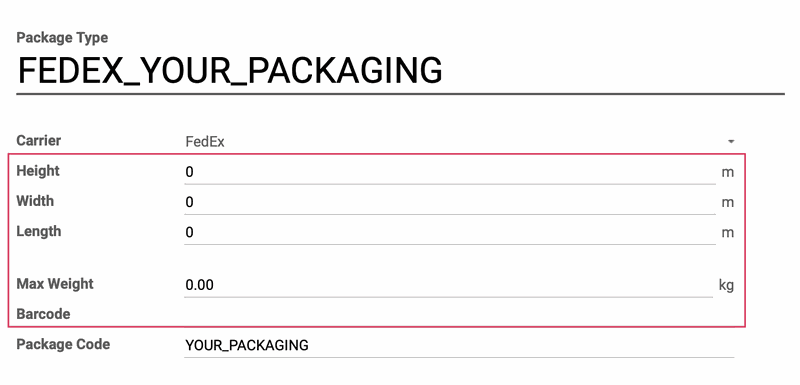
When the settings are configured to your requirements, click SAVE.
Good to Know!
Custom Packaging
It’s not uncommon to need multiple packages that are your own custom dimensions. In this case, you can have multiple package types that use the same custom packaging code. Set the package name to something identifiable by your team and ensure the Package Code is configured per the shipping provider's requirements.
To see what we've outlined in this document in action, refer to the Inventory > Delivery Methods Workflow documentation.
